![]()
![]()
![]()
Use LEFT and RIGHT arrow keys to navigate between flashcards;
Use UP and DOWN arrow keys to flip the card;
H to show hint;
A reads text to speech;
82 Cards in this Set
- Front
- Back
|
Historical Background of the Apparel Industry |
*Women were in charge of spinning fiber, weaving fabrics, and sewing clothes at home *women started sourcing yarns and fabric from markets as economy becomes more sophisticated * business clusters were formed for efficient buyer-supplier relationships Ex. Georgia and Carolinas cluster for cotton in U.S. *sourcing operations have expanded beyond clusters, states, and even across international boarders |
|
|
Current status of global sourcing |
*Global sourcing is common across many industries *labor-oriented businesses have moved from high-wage economies(or developed countries) to low wage economies (or developing countries since World War 2 *The U.S. is one of the largest apparel importing countries in the world--up to $120 billion (22.3% of the world apparel's import) in 2014. |
|
|
Pros Of Global Sourcing |
If done right global sourcing helps businesses to: * Reduce material/ operating costs *Improve Quality *Increase product availability *Respond quickly to changing market |
|
|
Cons of Global Sourcing |
If done irresponsibly, global sourcing could create: * Increasing rates of unemployment * Intensifying gaps between the rich and the poor within developing countries *Unfair labor practices in developing countries *Child labor exploitation *Negative Environmental Impact |
|
|
Definition of Global Sourcing |
Sourcing in the textile and apparel industry involves: *Making decisions regarding the amount of product needed * Identifying production sites capable of producing goods for retail *Negotiating prices and discounts * Maintaining relationships with the manufacturers during the production process, scheduling deliveries, following to ensure on-time delivery, and maintaining quality |
|
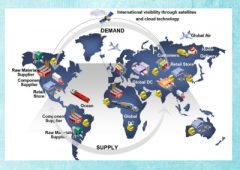
Sourcing |
*Sourcing tends to concentrate on acquisition and delivery of components or products or services from outside of the organization to the organization. *Sourcing: a set of businessprocesses and activities by which businesses acquire and deliver components or fully finishedproducts or services from outsideof the organization with theobjectives of finding, evaluating,and engaging suppliers of goodsand services to achieve long-term competitive advantages. |
|
|
Supply Chain |
A supply chain is a network of materials, information, and service processing links within the characteristics of supply, transformation, and demand. |
|
|
Supply chain management (SCM) |
*Supply chain management (SCM) is the systemic, strategic coordination of the traditional business functions within a particular company ...
*and across businesses within the supply chain for long-term performance of the individual companies and the supply chain as a whole *Global Sourcing is one of the activities under the SCM framework |
|
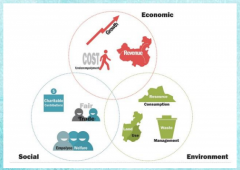
Goals of Global Sourcing Triple Bottom Line |
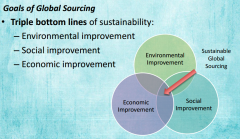
*Triple bottom lines of sustainability (SEE) -Social improvement -Environmental improvement -Economic Improvement |
|
|
Goals of Global Sourcing- Economic Improvement |
*Cost reduction by:
• Saving in labor costs; • Avoiding paying taxes or duties imposed byone country or another; • Reducing in production and transportationcost by finding a country nearby the sourcer;and/or • Reducing or removing risks. *Productivity growth by: • Focusing on its core competencies while sourcingspecial products from others. Value acquisition such as: • New, novel, one-of-a-kind products; • Personnel, skills, knowledge, or know-hows;and/or • Social or environmental values. *Quick response and flexible product supply by: • Analyzing market demands ; and/or • Identifying new trends. *Supply assurance by: • Maintaining both flexibility and supplyflow to maximize business performance. *Quality assurance by: • Minimizing defects and late delivery *Efficient capacity management by: • Managing optimal capital and labor; • Keeping critical resources and skills to keepcompetitive advantages. |
|
|
Goals of Global Sourcing-
The goal of social responsibility |
• Consumers’ satisfaction in addition to businesses’ goals
• Low cost vs. Poor labor practices? |
|
|
Goals of Global Sourcing- the goal of environmental responsibility |
• Long-term impact on the environments in addition to businesses’ financial goals
• Toxic chemical without proper water treatment vs. Low cost? |
|
|
The Triple Bottom Line and The Rise of the B Corp
|
• B Corp is a for “benefit” corporation.
• Each B Corp goes through a certification process to ensuretheir business is following the triple bottom line criteria. • B Corps are certified by the nonprofit B Lab to meetrigorous standards of social and environmental performance, accountability, and transparency. |
|
|
Sourcing Job Requirements and Responsibilities
Common Titles |
• Fabric or trim sourcing manager, assistant,coordinator, or merchandiser;
• Sourcing specialist, coordinator, manager ordirector; • Production/sourcing or sourcing/production;and • Merchandise sourcing/creative designer |
|
|
Sourcing Job Requirements and ResponsibilitiesCommon responsibilities
|
• Vendor management—identity, negotiate with,and select the vendors;
• Product development—must understand theprocess and acquire new materials for PDs; • Production—cost, delivery, quality, and legalcompliance; and • Internal collaboration |
|
|
Sourcing Job Requirements and ResponsibilitiesRequired Skills
|
-Organizational skills
– Multi-tasking skills – Communication skills – On the job experiences – Willingness to travel – Relationship skills |
|
|
Law of Supply and Demand |
*Demand and supply interact to determine the equilibrium price andthe quantity that will be traded in themarket.
• Four basic laws explained by theMarshallian cross: 1. If there is a high demand yet supplyremains unchanged, the equilibriumprice of the good and the quantity ofthe traded goods will increase. Ex. high demand for burken bag supply stays at 100 bags, price and quantity being sold increases D↑ S←→ P↑ Q↑ 2. If there is a low demand yet supplyremains unchanged, the equilibrium priceof the good and the quantity of thetraded goods will decrease. Ex. off trend popcorn t-shirt low demand, same supply, so they decrease price so they can sell them D↓ S←→ P↓ Q↓ 3.If there is a high supply yet demandremains unchanged, the equilibrium price of the good and the quantity ofthe traded goods will decrease. Ex. basic goods plain white t-shirt(high supply), demand unchanged, people only buying when they need, lower price D←→ S ↑ P↓ Q↓ 4. If there is a low supply yet demandremains unchanged, the equilibrium priceof the good and the quantity of thetraded goods will increase. Ex. commodity goods (milk,gas) supply sometimes gets low, there's still demand, price increases D←→ S↓ P↑ Q↑ *international trade occurs because it gives consumers access to products at world price (lower than the domestic price) * Yet, domestic producers will lose market shares to foreign goods *Retailers and consumers prefer international trade while domestic producers do not. *Due to this, the government has put up trade barriers such as tariffs and quotas *Tariffs are taxes imposed on imported goods *Quotas refer to the quantity limitations on imported goods to ensure there will not be too many imports in the market place |
|
|
Law of Supply and Demand Example |
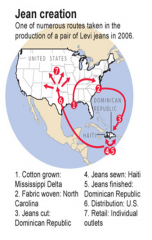
Law of Supply and Demand
The jeans are produced in other countries because the world price of jeans is cheaper than the domestic price, international trade causes prices to decrease so consumers want to buy the jeans at that price because they are more affordable so the demand increases, while fewer domestic suppliers want to produce the jeans because they are less profitable, so there is less domestic supply. So Levi’s will have jeans produced by foreign producers since it is cheaper. Global sourcing/ international trade helps give customers access to products at world price which is usually lower than domestic price, this threatens domestic suppliers. |
|
|
Comparative Advantage Theory
|
International trade occurs when 2 countries can gain from trade due to their different RELATIVE costs for producing the same goods Example: • If country A is relatively more efficient in producing product X than is country B • And country B is relatively more efficient in producing product Y • Then each country should focus on manufacturing X or Y and then trade them. *• Creates a division of labor and specialization. • Example: • Country A would have more labor involved in product X and country B in product Y. • Thus, the labor is divided between the two countries. |
|
|
Comparative Advantage Theory Example |
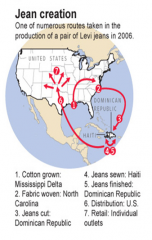
Comparative Advantage Theory Haiti is relatively more efficient in sewing jeans than the Dominican Republic and the U.S. while the Dominican Republic is relatively more efficient in cutting jeans and finishing jeans than the U.S and Haiti so Levi’s has the jeans cut and finished in the Dominican Republic and sewn in Haiti. The U.S. is relatively more efficient at growing cotton and weaving fabric than Haiti and the Dominican Republic so the cotton is grown and the fabric is woven in the U.S. |
|
|
Competitive Advantage Theory of Nations
|
• Firms’ competitive advantages are built from either low costs or differentiated products that command premium prices. • To sustain the advantage, firms must constantly innovate themselves to a higher-level of competitive advantage than before • To explain why certain nations achieve success in international trade, Porter introduced 4 attributes of a nation that can shape their competitive advantage. 1. Factor Conditions 2. Demand Conditions 3. Related and Supporting Industries 4. Firm Strategy, Structure, and Rivalry • Factor conditions: Factors of production refer to inputs necessary to compete in any industry, such as labor, land, natural resources, capital, and infrastructure. • Demand conditions: Demand conditions of the domestic (or home) marketplace influence how domestic firms improve and innovate their products or services. • Related and supporting industries: Having a competitive domestic supplier industry is much preferable to relying on foreign suppliers, even if they are well-qualified. • Firm strategy, structure, and rivalry: If the goals of firms, individuals (or employees), and a nation are all aligned, the industry in which these firms operate will be more likely to be competitive than that same industry in other nations without such a cohesive industry structure. |
|
|
Comparative vs. Competitive
|
*Compa(R)ative Advantage = (R)elative * Competitive Advantage = absolute |
|
|
Fragmentation Theory
|
• Fragmentation theory in international trade explains why countries trade parts and components. • Due to advances in transportation and communication technologies • AND reductions in trade and regulatory barriers • It has become easier for companies to divide production functions and share them with companies in foreign countries = International Trade • Allows for the division of labor and specialization. • Developed countries perform the value added activities, like design and marketing. • Developing countries perform the manufacturing activities. (production process fragmented, parted, separated into parts) |
|

Fragmentation Theory: Traditional Production Process |
Fragmentation Theory • Traditional production process *The production block in this model shows the production system in which inputs are organized and combined, and all production activities are performed in one or close location. |
|

Fragmentation Theory: Simple fragmentation process
|
• Simple fragmentation process • Inputs are transported into two separate production blocks and processed into the final products. • Introduction to Service Links •Includes: transportation, communication, and quality control |
|

Fragmentation Theory: Complex Fragmentation Process
|
• Complex fragmentation process *Multiple production blocks coordinated by multiple service links before final products are available in markets. |
|
|
Fragmentation Theory Example |
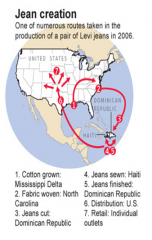
3. Fragmentation TheorySince the advances in technology and reduction in trade barriers so Levi’s has divided the production process. The cotton is grown in the Mississippi Delta and the fabric is woven in North Carolina. The jeans are cut in the Dominican Republic because the labor is cheaper and then they are sewn in Haiti because the labor is cheaper. The jeans are transported to and finished in the Dominican Republic and distributed in the U.S. and then to retail individual outlets. The U.S. specializes in the value added activities such as marketing and lets Haiti and the Dominican Republic do most of the manufacturing activities.
|
|
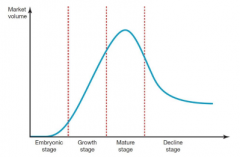
Industry Life Cycle Theory
|
• International trade occurs because an industry in different countries are at different stages of its life. • Four evolutionary stages for an industry: 1.The embryonic stage (starts as an embryo) 2.The growth stage 3.The mature stage 4.The declined stage |
|
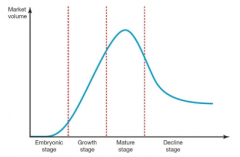
Industry Life Cycle Theory- Stage 1: Embryonic Stage |
*Market environment is uncertain *Product design is primal *Products are produced using unspecialized equipment |
|
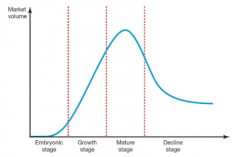
Industry Life Cycle Theory- Stage 2: Growth |
*Rate of product innovation declines and remains stable *Products are manufactured with more specialized machinery *Results in more refined products |
|
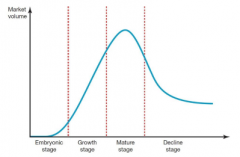
Industry Life Cycle Theory- Stage 3: Maturity |
*Business functions like marketing and management advance *Mature market with stable market shares *Seeking of external markets to develop new sales = International Trade *Stage 3 ends with decline = Stage 4 |
|

Industry Life Cycle Example
|
Industry Life Cycle Theory Haiti and the Dominican Republic are in earlier stages of economic development than the U.S. so they have comparative advantage in labor intensive sectors such as cutting the jeans, sewing, and finishing them. The U.S. is more focused on value added businesses such as design, branding, and product development, its economic development is so high that it lost its comparative advantage in the manufacturing process compared to the Dominican Republic and Haiti. |
|
|
Theoretical Perspective of Global sourcing Conclusions |
• There are different views on why firms are engaged in global sourcing. • Over 10 different theories explain global sourcing. • Not one theory explains it all. • A combination of these theories explain global sourcing. • Different companies may use different theories at any point of time. |
|
|
Resource Based View of the Firm (RBV)
|
strategic sourcing theory explains that firms are engaged in sourcing to acquire unique and valuable tangible and intangible resources
|
|
|
Resource Based View of the Firm (RBV) Example |

Resource Based View of the Firm (RBV) Levi’s is engaged in sourcing to acquire unique and valuable tangible and intangible resources from outside organizations to gain a competitive advantage. Levi’s picked sourcing options to gain or maintain rare, unique, and costly to copy resources. In Haiti and the Dominican Republic there are unique resources that the U.S. does not have. In the Dominican Republic they figured out and developed a machine to cut jeans much faster and cheaper than the U.S. and it is too costly for Levi’s to try and recreate their own machine to do that. Levi’s has the jeans sewn in Haiti because they is an abundance of highly skilled sewers there while in the U.S. there are a lot less and because in Haiti they figured out how to make stronger and cheaper thread that the U.S has not figured out. |
|
|
Resource Dependence Theory
|
strategic sourcing theory explains that certain decisions related to sourcing are made for firms to minimize their dependence on other firms *Resource Dependency theory argues that dependence on other firms' resources may not be helpful for a firm's competitive advantage and performance and, therefore, firms would make their sourcing decisions to minimize their dependence on other forms. Therefore questions on (a) how important the resources in need are and (b) how easily firms could acquire such resources in the market are important factors for firms' sourcing decisions. *For Example, firms would decide to source certain resources from outside organizations if they are not important for the firms' competitive advantage and performance could be performed by many suppliers. In this case, interdependence between the sourcer and supplier is not very important as the sourcer could easily find another supplier. If the resources aren't critical but could easily be performed by only a few suppliers, many decide to source from outside organizations. However, resource dependency theory suggests that firms may want to do so in a way that both sourcers and suppliers are highly interdependent. That is because the sourcer would not want to jeopardize the relationship with the supplier because they are only few that could deliver such resources. * On the other hand, if the resources in need are critical for the firm would be more likely to decide to make or buy such resources to posses permanent ownership of resources. Both options -make or buy- would allow the firm to reduce dependence on the supplier and increase the control of those resources. Finally, if the resources in need are critical yet many suppliers could deliver them, the supplier may want to form alliance or joint venture relationships with the suppliers. Alliance or joint venture relationships would be a less costly option than a making or buying option if the resources in need are difficult to obtain. However, alliance or joint venture relationships create more dependence of the firm on suppliers. Firms would have to know these different scenarios of sourcing options and make the best decisions for their competitive advantage and performance. |
|
|
Strategic Source Theory
|
*strategic sourcing theory that suggests that firms conduct sourcing to align their firms with the market environment. Some firms are engaged in sourcing to defend their market shares within the market environment. Others source to adapt to changes in market situations quickly. There are also firms that source to analyze new market situations or to react to such new markets * strategic choice theory suggests that firms make different sourcing decisions, depending on business problems that they would like to solve and strategic types that they like to implement to solve such problems *Strategic choice theorists suggest that top managers typically face 3 types of organizational problems: (a) entrepreneurial problems (b) engineering problems (c) administrative problems *in Miles and Snow's (1978) typology of business problems is the notion that different firms make different decisions to solve these problems in a different way, resulting in 4 different strategic types: (a) the defender-focuses on efficiently producing and distributing a certain set of goods and services in a predictable marketing environment. Therefore, a single core resource is the key to defend their businesses in the market. Therefore, defenders would not consider sourcing such resources (ex. Wal-Mart- one of the key success factors of Walmart is its everyday low-price strategies through efficient supply chain mechanism. Therefore, as a defender of the market it is not advisable for Walmart to consider sourcing its logistics, distribution, and other supply chain processes (b) the prospector- the prospectors are easily found in fast changing market environments and their goal is to adapt to changes in market situations. Therefore, they are consistently and constantly looking for new products or new services and new gaps in the market. Long-term commitments to a single resource or a single supplier are not desirable and, thus prospectors are deep into sourcing various resources to deliver different products or services. Fast- Fashion brands or retailers, such as Forever 21, face constant changes in consumers'' tastes and preferences. Thus, these companies constantly look for new suppliers who could deliver different technologies and products and it makes sense for them to source their products from various suppliers to quickly respond to market changes (c) the analyzer- show both defenders' and prospectors' aspects. Analyzers maintain a core base of both fundamental products and services while they seek new opportunities and markets. In terms of sourcing, these firms take a dual approach. To produce core products in fairly predictable market environments, top managers may decide to make such products internally. For fast-changing fashion products, top managers may decide to source them from outside organizations. Many of today's retailers take this analyzer's approach. They would like to maintain a balanced mix between core products (usually under private brand names) and fashion products (usually under designer brand names) to maximize performance and market responsiveness. (d) the reactor- reactors typically react to market changes and other firms' behaviors , therefore they lack consistency among sourcing strategies, business structures, and market environments. Sourcing decisions are made haphazardly without evaluation or long term prospects. They are less likely to be successful in the long run and maintain their business operations. |
|
|
Sociocognitive theory
|
a strategic sourcing theory that explains that sourcing decisions are an act of sense-making and reflection of organizational ability *According to this theory, firms with well-established structures and processes around sourcing strategies will more likely continue the same strategies. For example, if Levi's currently sources its zippers from certain zipper suppliers, it would be more likely to continue sourcing zippers in the future instead of making zippers internally. For similar reasons, organizational identity also plays an important role in sourcing decisions. If a firm has a strong sense of identity as an "American manufacturer," it will be more likely to decide to make products in the United States rather than source them from foreign countries. * sociocognitive theorists argue that sourcing decisions are sense-making activities as well as revelation of organizational identity. |
|
|
Critical Theory
|
strategic sourcing theory that explains that sourcing decisions are made to improve society in general, not just firms. *Therefore, critical theory suggests firms should make sourcing decisions to maximize social improvement, after comparing the benefits to society and short-term profitability. Social Improvement in critical theory includes equalities of gender, ethnicity, and race; emancipation of employees; alleviation of poverty in the world; and so on. EX. Tom's shoes is one of the examples of businesses whose mission is "to create a better tomorrow by taking compassionate action today" TOMs promotes the one for one movement under which Toms pledges to give a pair of new shoes to a child in need with every pair purchased. Although it is not certain where TOMS shoes are made internally or sourced from outside organizations, this type of strategic business decision can be explained by critical theory. |
|
|
Global Sourcing and the changed market environment
|
*Global sourcing fundamentally changed the nature of the global textile and apparel industry. *In 2012, the entire world exported over U.S. $709 billion (USD) worth of textiles and apparel. *In 2014, the entire world exported over U.S. $766 billion (USD) worth of textiles and apparel. *The U.S. imports more textiles and apparel than it exports *China exports more textiles and apparel than it imports *The EU imports and exports the same amt. of textiles A shift from the “old” to the “new” market environments within the U.S. textile and apparel industry. Old market environment *Domestic Manufacturing *Light Competition *Consolidated Process *Weak Consumerism New Market Environment *Global Manufacturing *Intense Competition *Fragmented Process *Strong Consumerism |
|
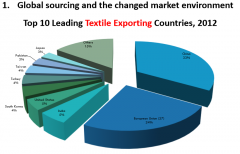
|
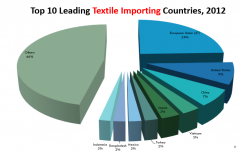
|
|
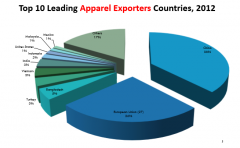
|
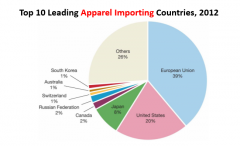
|
|

Old Market Environment
|
A shift from the “old” to the “new” market environments within the U.S. textile and apparel industry. Old market environment *Domestic Manufacturing *Light Competition *Consolidated Process *Weak Consumerism |
|

New Market Environment
|
A shift from the “old” to the “new” market environments within the U.S. textile and apparel industry. New Market Environment *Global Manufacturing *Intense Competition *Fragmented Process *Strong Consumerism |
|
|
Textile complex vs. softgoods industry
|
– FTA complex has been associated with phrases such as “dying industry,” “plant closing,” and “domestic job loss.” (“out”sourcing). – Retailers are now directly involved in manufacturing through global sourcing. Manufacturers are now retailing their own products. – A new term, the softgoods industry – Softgoods refers to nondurable goods that are usually made with textiles – Textiles refers to all of the products that the FTA complex produces—fibers, yarns, fabrics, apparel, and so on |
|

North American Industry Classification System (NAICS)
|
– Since NAFTA, three North American countries classify business activities following the NAICS. – NAICS uses a 2–6-digit hierarchical classification system (U.S. Census Bureau, 2011). First two digits = the economic sector, Third digit = the subsector, Fourth digit = the industry group, Fifth digit = the NAICS industry, and Sixth digit = the national industry. |
|
|
North American Industry Classification System (NAICS) Major Economic Subsectors
|
– There are 20 major economic sectors within NAICS. – The first two digits explain the economic sector to which a business belongs. – Most businesses in the textile and apparel industry belong to one of three economic sectors, (a) manufacturing [31–33], (b) wholesale trade [42], or (c) retail trade [44–45]. |
|
|
Wholesalers
|
*a major economic subsector – Wholesalers[NAICS 42]: Businesses “engaged in wholesaling merchandise, generally without transformation, and rendering services incidental to the sale of merchandise. It is an intermediate step. They sell goods for resale, sale of capital/durable non-consumer goods, and raw materials used in production. – wholesalers are categorized into two types of operations: *Merchant wholesalers *business-to-business [B2B] |
|
|
North American Industry Classification System (NAICS) Example |
•2-digit = manufacturing sector (31) •3-digit= subsectors like a textile mill or apparel manufacturing (313 or 315) •4 digit= industry groups such as, fabric mills, knitting mills, cut & sew manufacturing (3132 or 3135) •5 digit= industry, curtain and linen mills, hosiery and sock mills, cut and sew contractors (31521) •6-digit= national, infant cut and sew manufacturing (315291) |
|
|
Retailers
|
*a major economic subsector *Retailers [NAICS 44 and 45]: Businesses “engaged in retailing merchandise, generally without transformation, and rendering services incidental to the sale of merchandise. The retailing process is the final step in the distribution of merchandise; therefore, organized to sell merchandise in small quantities to the general public” (U.S. Census Bureau, 2011). |
|
|
Manufacturers
|
– Manufacturers [NAICS 31, 32, and 33]: Businesses “engaged in the mechanical, physical, or chemical transformation of materials, substances, or components into new products. The assembling of component parts of manufactured products is considered manufacturing” (U.S. Census Bureau, 2011).
|
|
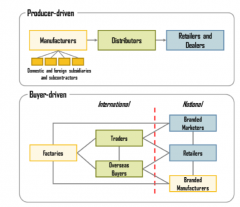
Retailers and Global Sourcing *CREATING "BUYER-DRIVEN" SUPPLY CHAINS RATHER THAN PRODUCER-DRIVEN |
– Retailers and global sourcing *Retailers are now directly or indirectly affecting global sourcing. *CREATING "BUYER-DRIVEN" SUPPLY CHAINS RATHER THAN PRODUCER-DRIVEN |
|
|
Wholesalers and Global Sourcing
|
– Wholesalers and global sourcing *Wholesalers engage in all aspects of businesses, including global sourcing, but without “product transformation.” *Many companies in the “new” market environment may be wholesalers, offering value-added services. *The term wholesaling “underestimates the importance of design, branding, marketing and logistics”. |
|
|
Import Intermediary
|
*Import intermediaries are defined as “domestic service firms linking domestic and foreign businesses to facilitate import transactions in the global supply chain.” *One of the main drivers of global sourcing in the new market environment. |
|
|
CHAPTER 3: GLOBAL TRENDS, BUSINESS TYPES AND GLOBAL SOURCING Conclusions |
– Wholesalers or import intermediaries are the main drivers of global sourcing, offering valueadded services to other firms. – These environments create identity crisis amongst businesses as to their main identify defined by the U.S. government. – This effects business reporting for the NAICS. |
|
|
Many companies in the "new" environment may be wholesalers, offereing value added services including design, product development, marketing, and branding
|
True
|
|
|
Make or Buy? Cost Minimization Criterion |
*Both production cost and service cost must be included to access the overall cost of product or part acquisition. Think about the cost of service links *Both internal and external costs associated with product acquisition must be considered (Ex. internal- salary, rent; external- outside walls of business, production) *Opportunity Costs (the value of something that must be given up to acquire something else) must be considered(trade offs) *the opportunity cost impacts the company's overall profits |
|
|
Make or Buy? Capabilities Criterion |
*the capabilities approach considers the fact that a significant amount of time and effort are necessary for any company to learn knowledge or skills * Sometimes, it is better to buy than make because of the time and effort needed to learn something new (ex. hiring someone, robots/technology, partnering) |
|
|
Make or buy? Risk Reduction Criterion |
*Risk Reduction criteria evaluates the degree of potential risks (recalls, safety, etc.) that a company might have in manufacturing components or products on its own *Businesses also face risks if they are not thoroughly prepared for aren't transparent w/ their business activities related to social and/or environmental responsibilities |
|
|
Sourcing options: Direct-Sourcing
|
*"Doing it all yourself" by acquiring and owning manufacturing facilities overseas *Advantages of direct sourcing: - Overall cost reduction in the long run; - Less expensive than hiring expert or purchasing finished products from other; -Direct control over production plans, delivery schedules, quality inspection, labor practices, and compliance; - core competency preservation in manufacturing innovating and differentiated production processes *Disadvantages of direct sourcing: -High fixed cost and knowledge in establishing new businesses in foreign countries -High risks in both quality and delivery for the sourcer if both fail -Limitation for the sourcer to explore new techniques or technologies that other factories might posses *When is direct sourcing preferred? -for a large retailer selling basic products repeatedly -for a company that owns unique manufacturing technologies or processes |
|
|
Sourcing Options: Cut, Make, Trim (CMT) Contracting
|
*The sourcer provides its own design, fabrics, and other raw materials -The suppliers are solely responsible for cutting the fabrics, sewing and assembling products, and trimming, such as adding hangtags, sorting, and packing *Because of the labor-intensive nature of the CMT processes, CMT suppliers tend to be located in developing countries *Advantages of CMT contracts: -Don't require significant fixed cost from the sourcer - More flexibility in product acquisition and in work w/ a variety of suppliers - Useful for sourcers in developed economies w/ limited experience and capital in apparel manufacturing * Disadvantages of CMT contracting -Losing some or all control over keeping design w/in the company as well as maintaining fabric inventory after delivering fabrics to the suppliers -changing factories and going to other countries comes w/ significant learning costs - the sourcer does not get profits from apparel manufacturing |
|
|
Sourcing Options: Full Package Sourcing
|
*Full-package suppliers are responsible for the entire sourcing process, from designing concepts to shipping documents *Depending on specific terms, shipping and transportation could be included, as well as marketing, merchandising, and technology information services (designers don't get credit) *Advantages of full-package sourcing- -The sourcer can focus on other core business activities other than sourcing -the sourcer needs little or no up-front investment - the degree of the sourcer's flexibility in full-package contracts is much higher than that in CMT contracts *Disadvantages of full-package sourcing -the lack of expertise makes the soucer rely heavily on the suppliers -the supplier's cost to the soucer is higher than with any other sourcing options(high risk of suppliers) |
|
|
Sourcing Options : Joint Venture Sourcing
|
*Two or more companies establish a new business entity and share profits as well as loss (ex. oxi-clean teaming up with arm & hammer for new detergent) *Joint venture makes it possible for small businesses or companies that lack certain expertise to gain new business opportunities *Advantages of Joint Venture Sourcing -low investment cost and fast start up - excellent access to businesses and markets through the foreign partner's expertise *Disadvantages of Joint Venture Sourcing: -does not bring the most profits to the sourcer -the sourcer might not have full control of the businesses, as the foreign partner might have different goals and objectives |
|
|
Factors for evaluating sourcing options: Cost
|
*Labor cost used to be the main factor in sourcing decision. However, this is no longer true (because of global sourcing, can go to other countries and get cheaper labor. *It is critical to evaluate production cost beyond labor cost *There are many other costs to include in calculating the final product acquisition cost- duties, transportation costs, etc. |
|
|
Factors for evaluating sourcing options: Quality *Finding the right suppliers that will provide the RIGHT quality, not necessarily the highest quality, is an important mission of the soucer |
*the quality of fabrics, trim, and workmanship is an important way to differentiate the company from competitors *Depending on the target consumers' wants and needs, the sourcer must consider different levels of quality *Finding the right suppliers that will provide the RIGHT quality, not necessarily the highest quality, is an important mission of the soucer |
|
|
Factors for evaluating sourcing options: Lead Time
|
*lead time is the total amt. of time required to receive goods from the suppliers from the moment the contract is issued *In highly fashionable products with a short selling season , lead time becomes even more important than overall costs |
|
|
Factors for evaluating sourcing options: Social and Environmental Compliance Issues
|
*Child labor has been an ongoing topic in global apparel-manufacturing industry *Nike has been accused of using child labor in 4 countries since the late 1900s *Other labor issues include: prison labor, forced labor, and late or no compensation *The sourcer must find suppliers that comply with fair labor practices and often are certified by third-party organizations *Being sustainable in both social and environmental arenas is important for today's consumers |
|
|
Factors for evaluating sourcing options: Place
|
*The place factor includes not only physical infrastructure of the suppliers' facilities, but also the overall climate of the country in which suppliers operate *lack of gov't support for import and exports also could be a problem for the sourcer *Both bureaucratic procedures and lack of gov't infrastructure would delay exporting, transportation, modes, and payment |
|
|
Factors for evaluating sourcing options: Consistency
|
*Consistency is the most important factor -supplier's optimal cost, quality, lead time, compliances, and infrastructure * Checking the supplier's past records and reputation w/ regard to consistency in its price, quality, lead time, labor, and environmental practices, and overall infrastructure is vital
|
|
|
6 supply chain functions in global supply chain management of textiles and apparel *History/Forecasting *Consumer Research *Product Development *Merchandising *Sourcing/Production *Retailing/Distribution |
1. Using the model of global supply chain management of textiles and apparel (see pg 11 of your textbook), explain how each of the six supply chain functions affects other supply chain functions to achieve economic, social, and environmental goals. Give one specific example. For example, think about (a) how a designer in TOMS shoes approaches his or her design function for environmental goals? And (b) How such an approach would affect the activities of other functions? The answers could be (a) A TOMS shoe designer selects only one type of raw material, canvas, to reduce waste during the shoe production. This will help improve the environment. (b) The trend forecasters would need to examine past sales of canvas shoes to determine if quantities of materials are available to produce the new line. Additional information might be provided by the sales department who studies the consumption behaviors of loyal customers. Additionally, this approach will affect the product developer who now needs to find a way to make a pair of shoes using only canvas. Merchandiser will have to carefully select color assortment planning. Marketer would have to come up with effective advertising campaign strategies to communicate this unique goal. Retailers may want to have a designated area of their selling floor to communicate this particular cause and efforts. |
|
|
Buckle
|
*Buckle operates over 450 retail stores in 44 states *1948Buckle began as Mills Clothing, a men's clothing store in Kearney, Nebraska. |
|
|
Which of the business activities are required to conduct successful global sourcing?
|
a. marketing and merchandising b. purchasing and accounting c. designing and product development d. only A and B e. all of the above |
|
|
which of the following is a supply chain member of cotton apparel?
|
a. a cotton farmer in Missouri b. a cotton apparel sewing factory in Bangladesh c. a cotton apparel designer in New York d. only A and B e. all of the above |
|
|
which of the following are the triple bottom lines of sustainable global sourcing?
|
economic, social, and environmental improvement
|
|
|
a major U.S. retailer wants to tap into a new market into the Brazilian market. yet it has little knowledge about Brazilian retailing nor consumers. therefor, it formed a partnership agreement with a major retailer in brazil who has extensive experience and knowledge about brazil. this apprach is called ________?
|
joint venture
|
|
|
hanes, a sock and underwear brand in the U.S. , decided to close their manufacturing facilities in North Carolina and moved their production facilities to el salvador in late 2000s. the salvadorian factories are owned by hanes and Hanes now make the majority of their products from these salvadorian facilities. this describes a ________ option.
|
Direct Sourcing
|
|
|
A coat of many countries (suit)
|
Australia - said to have the best wool India- fabric, textiles china- shoulder pads Seoul, south Korea- linings Canada- buttons Germany- transportation Moscow, Russia - suit assembly North America |
|
|
NAICS - first 2 digits
|
economic sector ex. manufacturing sector (31) |
|
|
NAICS- third digit
|
subsector ex. like a textile mill or apparel manufacturing (313 or 315) |
|
|
NAICS - 4th digit
|
industry groups ex. such as fabric mills, knitting mills, cut & sew manufacturing (3132 or 3135) |
|
|
NAICS - 5th digit
|
NAICS industry ex. curtain and linen mills, hosiery and sock mills, cut and sew contractors (31521) |
|
|
NAICS - 6th digit
|
the national industry (which country it comes from)
|

